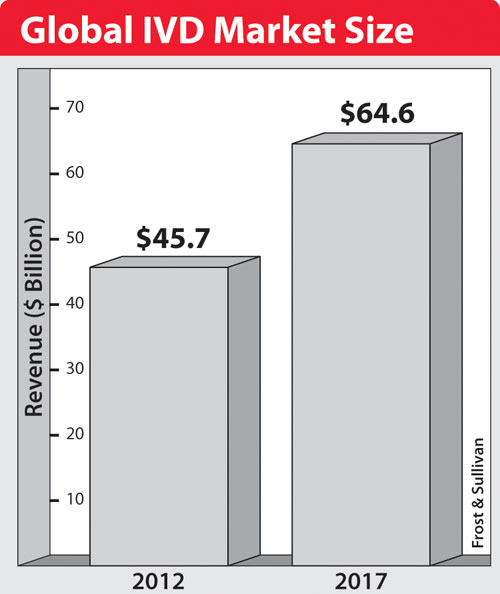May 1, 2013 (Vol. 33, No. 9)
Alluring Emerging Markets Include BRIC Countries As Well As Indonesia and Vietnam
In our most recent analysis, global in vitro diagnostics (IVD) sales revenue including reagents, consumables, instrumentation, and services totaled $46 billion in 2012 and are expected to reach $65 billion in 2017. Annual revenue growth for IVD is steady at 7% and slightly rosier than that of the pharmaceutical market at 5% annually through 2015. The emerging theme in this research was the increasing globalization of the industry, not only as a factor in market leadership, but also as a critical organic growth strategy for most IVD companies to avoid being engulfed by industry consolidation.
In 2009, Roche Diagnostics, Siemens Healthcare, Abbott Laboratories, the Ortho Clinical Diagnostics division of Johnson & Johnson, and Beckman Coulter (now Danaher) had 60% of the market share. In 2012, their share grew to 63%. The second tier group containing Alere, Bayer Diabetes Care Division, bioMerieux, Sysmex, and Becton, Dickinson and Co. also expanded its market share in three years from 16% in 2009 to 18% in 2012. The remainder competes for a slice of the market that shrunk by 5% in the last three years.
The future holds challenges for both the market leaders and niche suppliers. Large global IVD companies will continue expansion through acquisition, but will struggle to deliver organic growth, which was already apparent in 2012. The competition will further intensify for niche suppliers as growing numbers of their customers, namely physician practices, are unable to remain profitable.
In an analysis of more than 40 companies with IVD sales, we found that the most competitive deployed one or all of three key strategies. The most successful companies first and foremost defended market share by supporting their current installed base. Existing customers and their loyalty are paramount in a business driven by recurring revenue from high-throughput analyzers. Second, competitive companies penetrated high-growth markets like specialty diagnostics and emerging markets. The third was investment in enabling technologies like next-generation sequencing and digital PCR. Out of the list, entering emerging markets is broadly applicable across all IVD companies no matter what size the company and, thus, important for all to consider.
Ex-U.S. Demand for Routine Testing Drives Growth
At the IVD segment level, immunochemistry is driving the growth of the entire industry due to a predicted 7% annual growth rate on an $18.8 billion market. While the molecular diagnostics segment is forecast to grow at more than 12% annually, it will become a $9 billion industry in 2017 (compare that to immunochemistry’s forecasted sales at $30 billion in 2017). A closer look at the immunochemistry market, which includes immunoassays, clinical chemistry assays, and related analyzers, determined that most of the growth is driven by demand outside of the United States.
By analyzing self-reported company-installed base data, we find that out of approximately 18,000 installed automated immunoassay analyzers, chemistry analyzers, and integrated analyzers, as low as 17% are installed in the United States, signifying the larger market potential outside of the United States.
In fact, our research found that the United States IVD market growth at 6% lags behind that of Latin America (9%), Eastern Europe (10%), and Asia-Pacific (12%) markets. Strong demand for integrated analyzers combining both immunoassay and clinical chemistry functions, specifically from markets like China, strongly factors into the growth trajectory for not only the immunochemistry segment, but also the total global IVD market.

Global in vitro diagnostic sales revenue, including reagents, consumables, instrumentation, and services, is expected to reach $65 billion in 2017, driven largely by the increasing globalization of the industry.
Opportunities Abound for Big and Small Companies in Emerging Markets
The BRIC countries, or Brazil, Russia, India, and China, were the initially identified emerging markets, sharing in common growing public health investment, health infrastructure modernization programs, and rising socioeconomic classes that demand and can afford Western medicines and treatments, which are particularly evident in the growth of private health plans in Brazil. While there is unmet need for IVD tests and instruments in major hospitals such as those in China, affordability has been a hurdle.
IVD companies adjusted pricing, perhaps through scaled-down instruments, but compete against cheaper and low-quality products that fit the region’s cost structure. In all countries, patient access has been an issue due to cultural attitudes that result in infrequent visits to the doctor or inconsistency in disease management by medical providers.
Despite the challenges, emerging IVD markets should be a part of every large IVD company’s strategy as these markets are outpacing IVD growth in the United States and Europe.
Small IVD companies also have special opportunities to fill in product gaps within distributors’ catalogs that result when large companies make acquisitions and consolidate sales channels. We have identified a number of “second-wave” emerging markets in the Asia-Pacific region. We believe Indonesia and Vietnam to be promising second-wave IVD markets for their similarities to the BRIC countries, with the added bonus of a favorable attitude toward imports in Indonesia—at least, currently.
Winny Tan, Ph.D., is an industry analyst in the life sciences group at Frost & Sullivan. For more information, email: [email protected].



